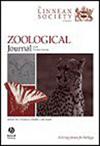Revised phylogeography of the common brushtail possum (Trichosurus vulpecula) reveals new insights into genetic structure across Australia
IF 2.8
2区 生物学
Q1 ZOOLOGY
引用次数: 0
Abstract
Understanding genetic relationships within species is essential for identifying distinct genetic lineages and informing conservation strategies, particularly for species with fragmented or widespread geographic distributions. One such widespread species that has suffered declines across Australia, despite remaining common in some areas, is the common brushtail possum (Trichosurus vulpecula), a nocturnal and arboreal marsupial. Previous genetic studies on brushtail possums had limited sampling, which has precluded a comprehensive assessment of the relationships within the species and genus. Using both single nucleotide polymorphism markers and the mitochondrial cytochrome b gene, this study employed phylogenetics, ancestry coefficients, and tested genetic differentiation, to examine the population structure of brushtail possums across Australia. Our results indicate that current subspecies’ classifications of T. vulpecula do not align with genetic structure, as Western Australian Pilbara and Midwest populations, currently defined as the subspecies Trichosurus vulpecula hypoleucus, are instead genetically similar to south-eastern and central T. v. vulpecula. These findings have important implications for current conservation strategies, including translocations of brushtail possums, and highlight the importance of comprehensive genetic sampling within wide-ranging species.修订的常见刷尾负鼠(毛鼠)的系统地理学揭示了对澳大利亚遗传结构的新见解
了解物种内部的遗传关系对于确定不同的遗传谱系和制定保护策略至关重要,特别是对于地理分布分散或广泛的物种。尽管在某些地区仍然很常见,但在澳大利亚范围广泛的物种之一是常见的刷尾负鼠(Trichosurus vulpecula),这是一种夜间和树栖有袋动物。以前对帚尾负鼠的遗传研究取样有限,这妨碍了对物种和属之间关系的全面评估。利用单核苷酸多态性标记和线粒体细胞色素b基因,本研究采用系统遗传学、祖先系数和测试遗传分化来研究澳大利亚各地的帚尾负鼠的种群结构。我们的研究结果表明,目前的T. vulpecula亚种分类与遗传结构不一致,因为西澳大利亚皮尔巴拉地区和中西部地区的种群,目前被定义为亚种的T. v. vulpecula与东南部和中部的T. v. vulpecula遗传相似。这些发现对当前的保护策略具有重要意义,包括对刷尾负鼠的易位,并强调了在广泛物种中进行全面遗传采样的重要性。
本文章由计算机程序翻译,如有差异,请以英文原文为准。
求助全文
约1分钟内获得全文
求助全文
来源期刊
CiteScore
6.50
自引率
10.70%
发文量
116
审稿时长
6-12 weeks
期刊介绍:
The Zoological Journal of the Linnean Society publishes papers on systematic and evolutionary zoology and comparative, functional and other studies where relevant to these areas. Studies of extinct as well as living animals are included. Reviews are also published; these may be invited by the Editorial Board, but uninvited reviews may also be considered. The Zoological Journal also has a wide circulation amongst zoologists and although narrowly specialized papers are not excluded, potential authors should bear that readership in mind.

 求助内容:
求助内容: 应助结果提醒方式:
应助结果提醒方式:


